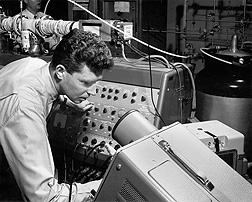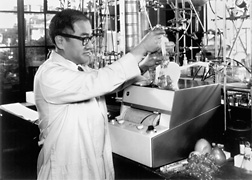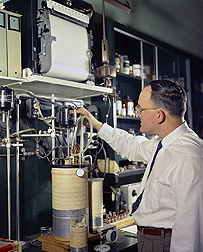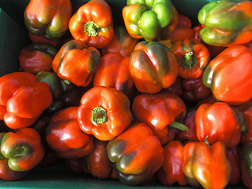Cited for More Than 60 Years of Flavor Research
It’s a unique scientific niche that touches the lives of everyone.
Flavor chemistry is one of several areas of research conducted at the Agricultural Research Service’s Western Regional Research Center (WRRC) in Albany, California. The WRRC’s achievements in flavor chemistry have earned it the distinction of being named a 2013 National Historic Chemical Landmark by the American Chemical Society (ACS). The ACS is the world’s largest society of chemists, and its prestigious National Historic Chemical Landmarks program grants landmark status to seminal achievements in the history of chemical science in the United States that have had a significant impact on the chemistry profession and the public.
The WRRC research being cited by the ACS revolutionized the field of flavor chemistry by identifying major flavor compounds and developing both techniques to evaluate flavor constituents and analytical tools and methods to study flavor. The award reflects a huge body of research by a team focused on determining the chemical “essence” of flavors and odors.
|
|
“We’re extremely honored to be receiving such an award, and I think it shows the significance of the work that has been done here in the past and that we continue to build on,” said Howard Zhang, director of the WRRC.
The WRRC is the only research center in the 21-year history of the ACS program to receive two historical landmark awards for its research. It also received the award in 2002 for frozen foods research, known as the “Time-Temperature Tolerance studies.”
An event to mark the designation of flavor chemistry research as a National Historic Chemical Landmark will take place at WRRC later this year. More information about the Landmarks program is available at www.acs.org/landmarks.
The Importance of Flavor
Having an ample supply of processed food ensures longer storage times and a more stable food supply, but ensuring quality presents its own set of challenges. The increased marketing of processed foods began in the years after World War II, but it prompted concerns about the loss of flavors that accompanied preservation by drying, freezing, and canning. An estimated 10,000 new processed foods are introduced each year, and almost all of them require flavor improvements.
|
|
Ensuring quality flavors is important. Frozen foods, snack items, soft drinks, prepackaged meals, and confections together represent a $600 billion processed-food industry. Studies have shown that appearance and packaging play a major role in whether someone will purchase a new food product, but flavor plays a big part in whether they buy it again.
What gives food its flavor is an extremely complicated balancing act. Cooking a French fry produces an aromatic blend of compounds that gives the fry much of its flavor. When a health-conscious public expresses a need for fries cooked in “healthier” oils, the specific oil used can alter the flavor. The same is true with vitamins and minerals used to fortify breads, cereals, and pastas. Chemical structures of compounds in cooking oils and vitamins, even when those compounds are present at levels of only a few parts per million, can have major effects on taste. Highly sensitive tools are needed to separate and characterize very low concentrations of the flavor constituents.
|
|
New technologies and analytical methods, developed at WRRC, have met that need and have led to an impressive list of accomplishments. We may not see the results, but they are evident in what we eat every single day. They have also helped to lay the foundations for numerous advances in modern analytical chemistry and have spilled over into other scientific areas, such as food safety and human health, according to Bill Orts, research leader for WRRC’s Bioproduct Chemistry and Engineering Research Unit.The work includes many “firsts.”
Gas Chromatography
WRRC scientists Keene P. Dimick and Lloyd Ingraham designed and built one of the world’s first practical gas chromatographs in 1953 and, with colleague Joseph Corse, used it to separate and identify the volatile flavor components of strawberries. Thanks to work by WRRC chemists, gas chromatography quickly became an essential tool for studying flavor and aroma.
Sophisticated gas chromatography methods were developed at WRRC to measure food quality through flavor, including detection of off-flavors. WRRC scientists Ron Buttery and Roy Teranishi were the first to analyze aroma compounds in 1961 by injecting the vapor collected above a food into a gas chromatograph. The method, termed “static headspace analysis,” is useful for tracking rancidity in stored foods. It became standard throughout the food industry and is also widely used to measure blood alcohol levels, detect residual solvents in pharmaceutical products, and analyze organic compounds in soils.
|
|
WRRC researchers have conducted many fundamental studies on off-flavors. Buttery and co-workers identified bis(2-methyl-3-furfuryl) disulfide, one of the most potent odorants and known as the compound responsible for the odor of vitamin B1 (thiamin). The compound has an intense savory, meaty aroma and is an important component of beef gravy, high-heat skim milk powder, cooked brown rice, and soybean protein. It is also an off-flavor in stored orange juice.
WRRC scientists identified geosmin as the compound responsible for a musty off-flavor in dry beans, and they found that a “cinnamonlike” off-odor present in baked bread and wheat flour was from coumarin, traced to clover seeds inadvertently contaminating the wheat flour.
In the 1960s, Teranishi and WRRC scientist William H. McFadden combined sophisticated gas chromatography (GC) with mass spectroscopy (MS) and used their “capillary temperature programmed GC-MS technique” to identify complex mixtures of volatile chemical compounds, such as those that give flavor to strawberries. The technique was quickly picked up by scientists around the world and is now used routinely in chemical research. WRRC scientists used it to identify key aroma components in oranges, apples, bread crust, bell peppers, potatoes, corn tortillas, artichokes, and red beets.
|
|
Nuclear Magnetic Resonance
WRRC researchers built a nuclear magnetic resonance instrument in the late 1940s, several years before commercial models became available, and used it to determine the moisture content of different foods. Albany researchers modified it in the 1960s, and using a “time averaging computerized system” designed at WRRC, they were able to measure various compounds from as little as 50 micrograms of material, a far smaller sample size than previously needed.
Working with bell peppers, Buttery used the instrument to identify methoxypyrazines, an important class of odorants. In a landmark paper, he isolated and identified the “character impact compound” in bell peppers as 2-isobutyl-3-methoxypyrazine. The compound has been shown to be a key flavor constituent of certain wines as well as peas, green coffee, certain cheeses, chili peppers, and other varieties of peppers. Scientists now synthesize it, using methods developed by Buttery, and it is marketed in the United States and Europe as a food flavor.
Buttery and a co-worker synthesized eight related new alkyl-methoxypyrazines, and that work led to the discovery of a new group of very significant flavor compounds. One of the synthesized compounds, 2-methoxy-3-isopropylpyrazine, is a major contributor to the earthy aroma and flavor of potatoes.
Aromatic Rice and Orange Oil
Buttery was the first to identify a flavor compound, 2-acetyl-1-pyrroline (ACPY), a major contributor to the flavor of aromatic rice, which commands a premium price because of its unique aroma. After WRRC researchers published their work, ACPY was identified as a major contributor to the flavor of bread, cooked beef, popcorn, and sweet corn products.
|
|
WRRC scientists were the first to identify alpha- and beta-sinensal as major contributors to the character and quality of orange oil, sweet orange oil, and mandarin oil. Alpha-sinensal has an intense orange scent accompanied by distinct floral notes, and beta-sinensal has a metallic-fishy odor that can lead to objectionable odors in higher concentrations.
Volatiles as Breath Detectors and Odor Thresholds
In collaboration with Nobel Prize winner Linus Pauling, Teranishi carried out the first scientific studies of breath analysis in the early 1970s, demonstrating that human breath contains more than 200 volatile organic compounds. Today, breath analysis is used for blood alcohol testing and as a preliminary test for detecting certain cancers, diabetes, asthma, and Helicobacter pylori infection.
Although early flavor research focused mainly on identification of volatiles, attention was also paid to their sensory importance. Odor thresholds of volatile compounds (the concentration at which the compound is detectable) can vary widely and make a big difference in how a food smells and tastes. Ethanol, for instance, has an odor threshold of 100 milligrams per liter, while the character impact compound of bell peppers has an odor threshold of just 0.000002 milligrams per liter. WRRC scientists have determined the odor thresholds of hundreds of volatiles, and the results have been important to flavor researchers around the world.
Progress: From Hundreds of Compounds to Thousands
Efforts that began at the WRRC in the 1940s continue today. The progress made may be most evident in some key numbers from the field of flavor chemistry. Before the 1960s, researchers had to process tons of food to isolate sufficient samples for sensory and chemical studies, and so they had correlated only about 500 compounds to specific sensory properties. But by the 1990s, with help from new technologies and methods, scientists had identified and characterized more than 7,000 flavor/odor components.
Says Tara McHugh, research leader of WRRC’s Food Processing Research Unit, “Processed foods are an important part of the nation’s food supply, and the technology developed here will continue to help us ensure that the supply is safe, marketable, and of high quality and that the food tastes good to even the most discriminating palates.”—By Dennis O'Brien, Agricultural Research Service Information Staff.
To reach scientists mentioned in this article, contact Dennis O’Brien, USDA-ARS Information Staff, 5601 Sunnyside Ave., Beltsville, MD 20705-5129; (301) 504-1624.
"Cited for More Than 60 Years of Flavor Research" was published in the May/June 2013 issue of Agricultural Research magazine.













